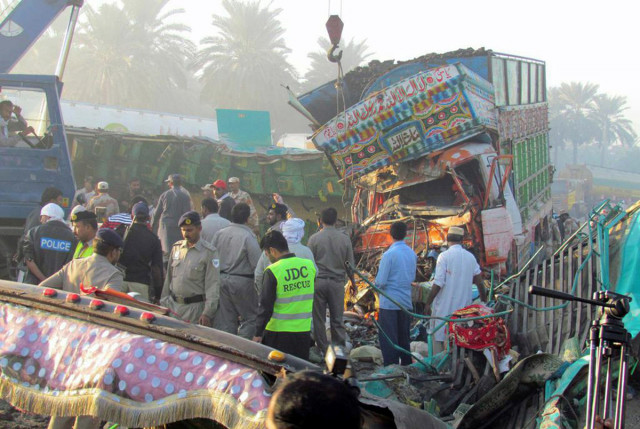The daily massacre
Traffic-wise, Karachi is something of a war-zone with an average of one person a day being killed and 83 injured daily

The national picture regarding traffic fatalities and casualties is equivalent to the kinds of casualty list that might accompany a low-intensity conflict, a small war. PHOTO: AFP

The numbers who die as a result of terrorism are known with a fair degree of accuracy, but the numbers who die or are injured on the roads is approximate at best and significantly underestimated at worst. Law-enforcement agencies offer differing figures for casualties, with the report of traffic incidents in 2014 a case in point. The Islamabad Traffic Police (ITP) say 65 people died last year, and the Islamabad Capital Territory (ICT) police say 110 making for a wide discrepancy. There is another gap in the figures for injured — the ITP say 90 and the ICT police say 101; but both agencies agree that the figures for dead and injured were down on the 2013 figures.
Traffic-wise, Karachi is something of a war-zone with an average of one person a day being killed and 83 injured daily. Extrapolation of those numbers gives at least 365 killed a year and a staggering 30,295 injured. Again, this is an incomplete picture even though casualties are monitored at five of Karachi’s largest hospitals, as not all those who die in accidents get to hospitals and many ‘walking wounded’ do not get to hospital either. The cause of accidents in Karachi are varied, but the proliferation of signboards, use of a mobile phone while driving or riding a motorcycle and the abysmal condition of many roads are high on the list. One does not have to be a driver to become a victim, and pedestrians are also at hazard in part because they are forced to walk on the carriage way as result of encroachments. Pedestrians are the second largest casualty group in Karachi.
Balochistan had a particularly bad year in 2014 with 240 dead, the highest for four years. Considering how thinly populated the province is, this figure is of particular concern. All of the same elements are there for Balochistan as everywhere else but with the added ingredient of illegally-carried petroleum products resulting in multi-fatality accidents. “Reckless driving” is cited as the root cause of many accidents. The picture in Lahore and Punjab generally is slightly better, with the density of traffic meaning that speeds in cities are lower, meaning fewer fatalities. Motorcyclists are again cited as a primary victim as well as a primary cause of accidents.
The national picture regarding traffic fatalities and casualties is equivalent to the kinds of casualty list that might accompany a low-intensity conflict, a small war. The cost to the national economy is incalculable and there has been little or no effort to make the calculation nationally anyway. High-profile accidents where there are mass-casualties usually produce a political call for ‘action’ or the formation of a committee to investigate but there is no national plan to address what is clearly a national problem of major proportions. There are occasional attempts to introduce road safety education into the curriculum but it is patchy in application and reaches a minority of children rather than a majority. There are few votes in road safety so it is never high on the agenda of local politicians and provincial budgets rarely get stretched around much other than token traffic-calming speed-humps. So far, the traffic is winning this war.
Published in The Express Tribune, February 10th, 2015.
Like Opinion & Editorial on Facebook, follow @ETOpEd on Twitter to receive all updates on all our daily pieces.















COMMENTS
Comments are moderated and generally will be posted if they are on-topic and not abusive.
For more information, please see our Comments FAQ